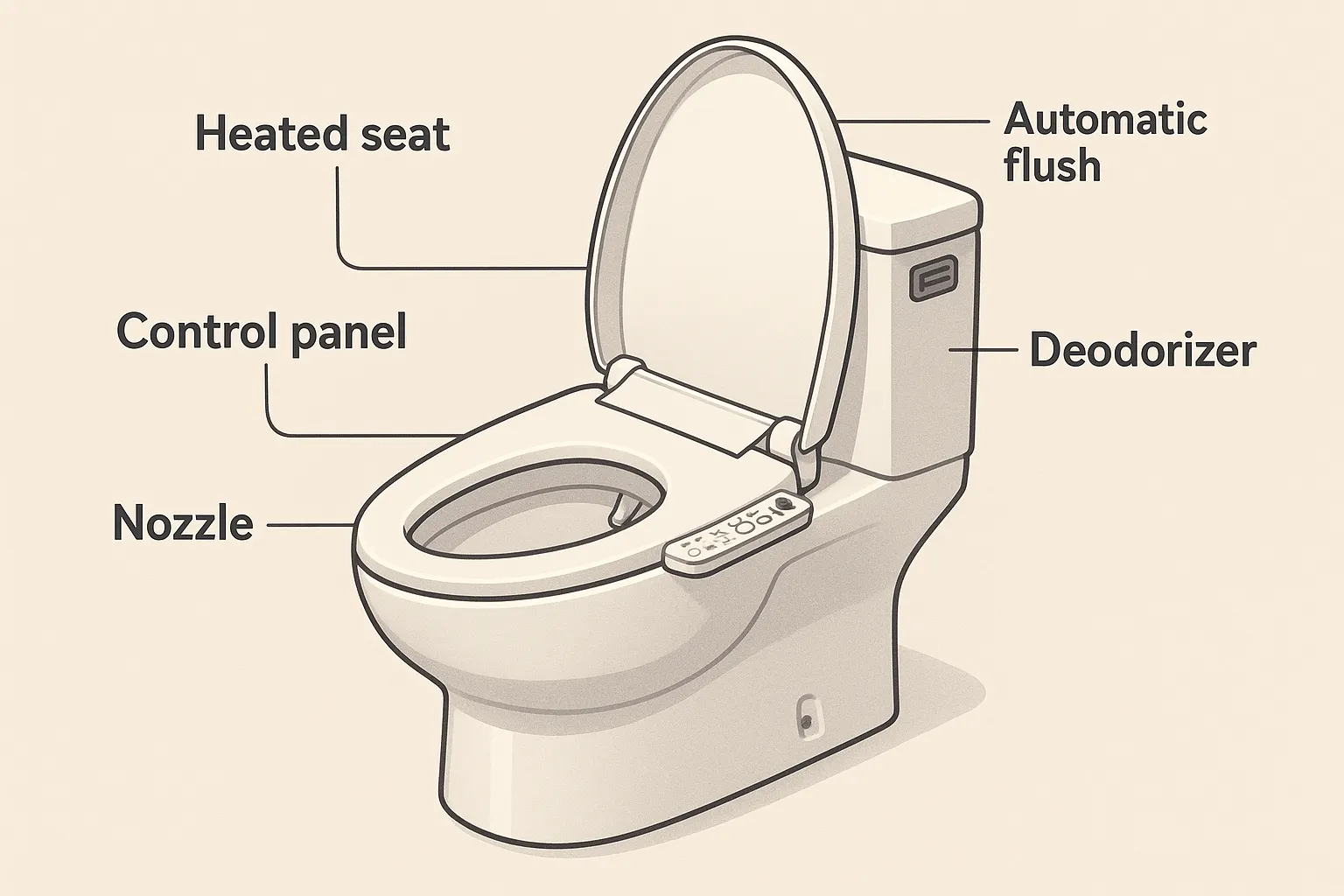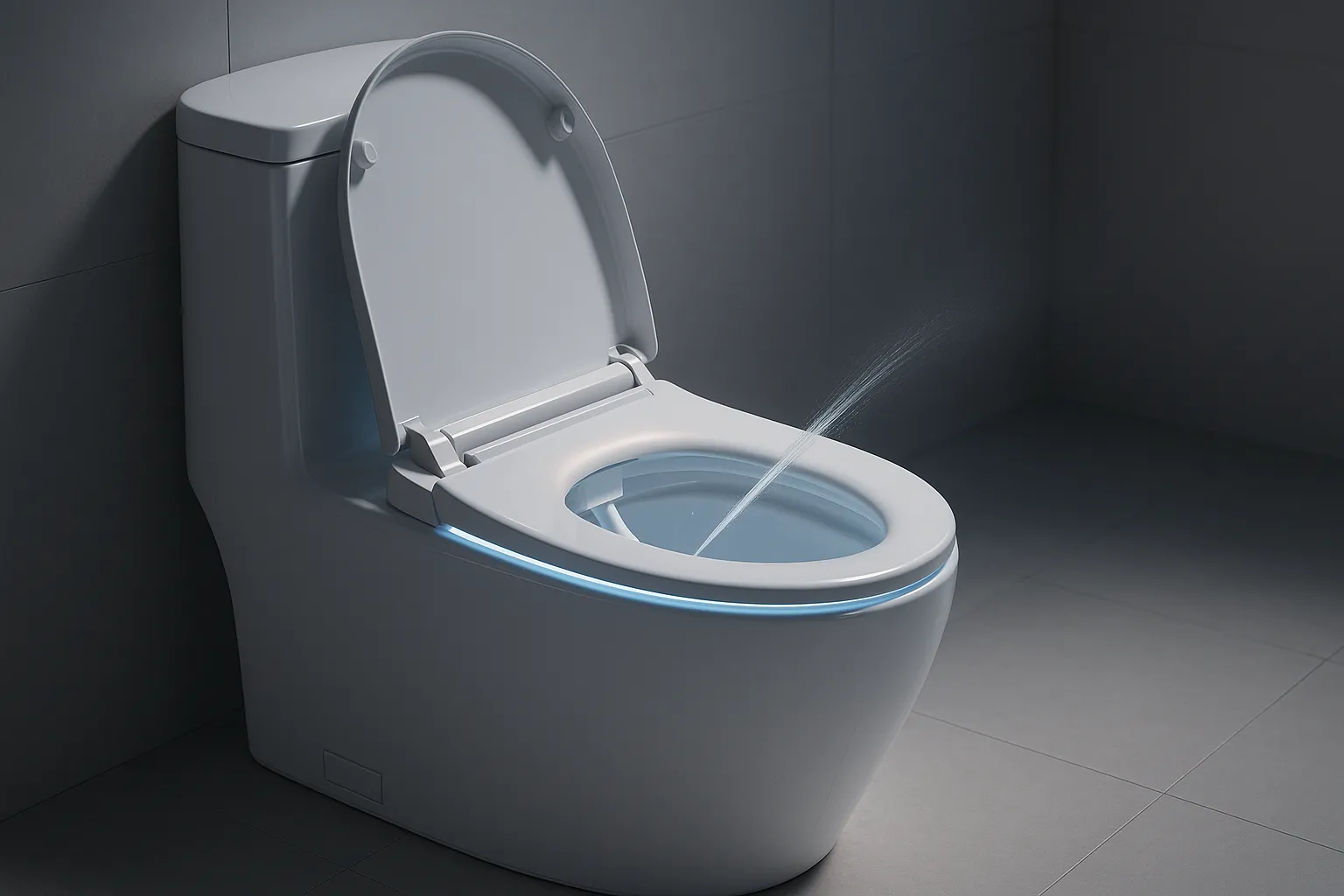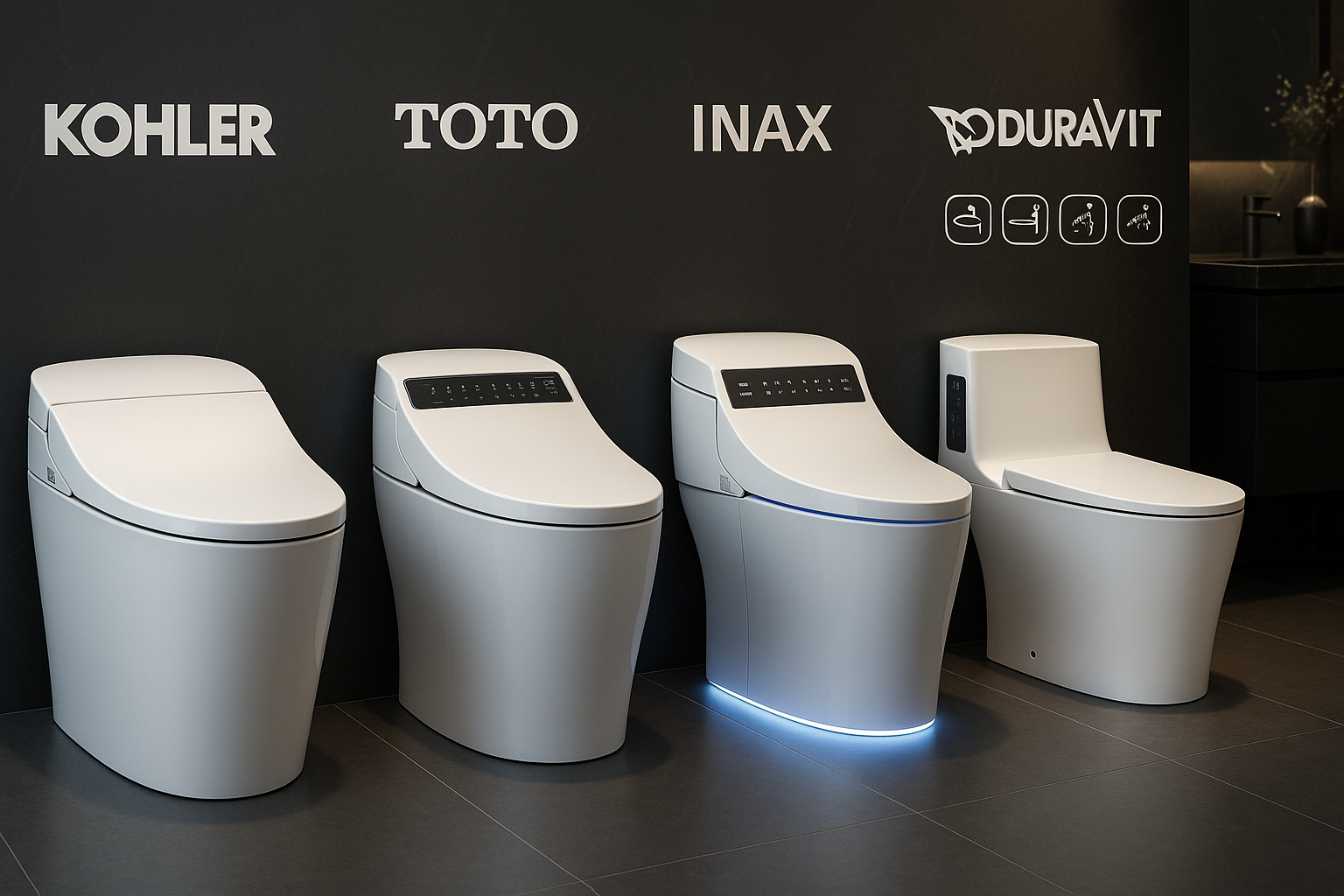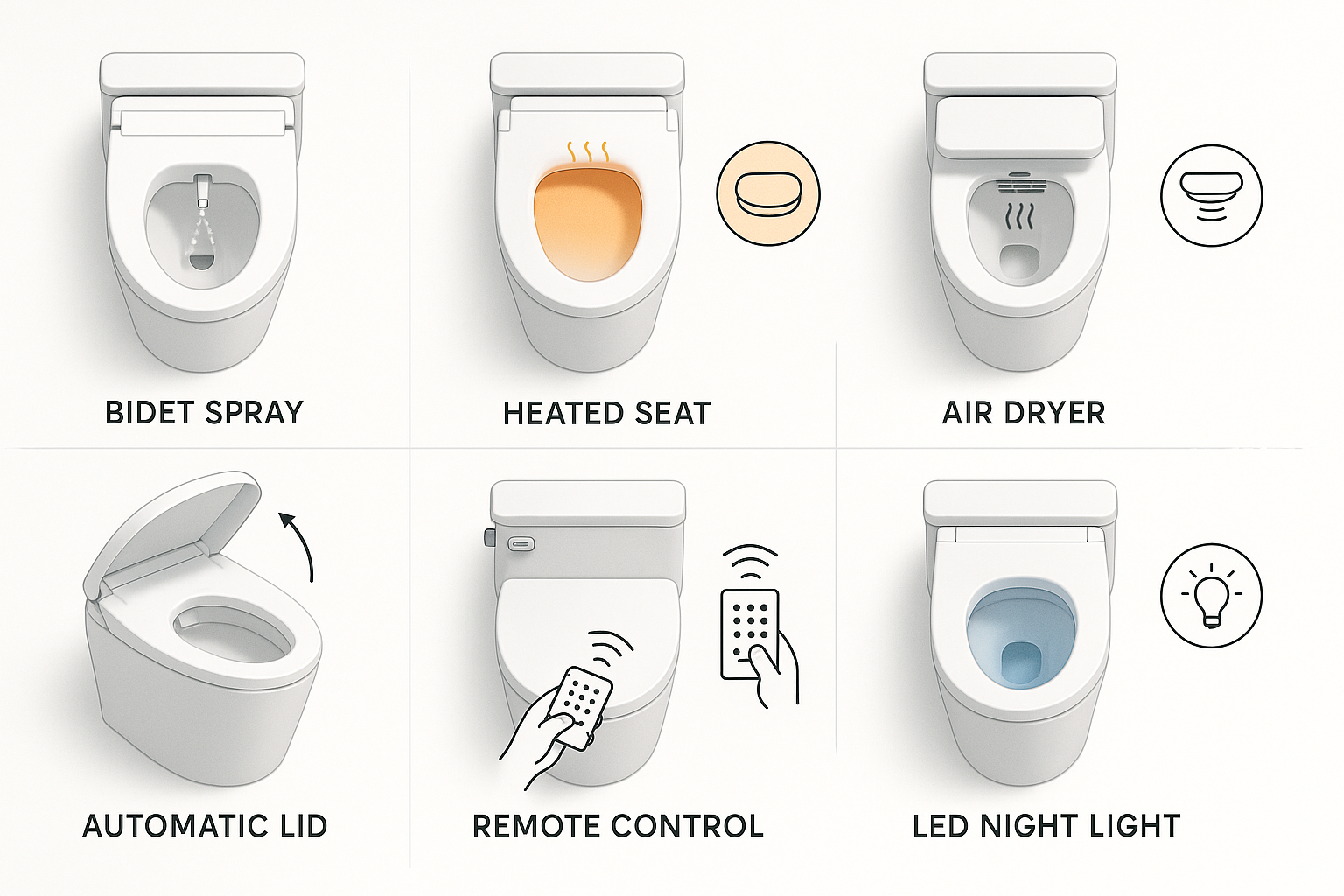Smart toilets are revolutionizing the way we think about bathroom fixtures. They combine technology with eco-friendly features to enhance comfort and sustainability.
These innovative toilets are designed to save water and reduce waste. They offer a modern solution to traditional bathroom challenges.
With features like automatic flushing and bidet functions, smart toilets minimize water usage. They also reduce the need for toilet paper, promoting a greener lifestyle.
Brands like Kohler lead the market with cutting-edge designs. Their smart toilets are a testament to the power of innovation in sustainable living.
As more consumers prioritize eco-friendly options, smart toilets are becoming a key component of modern homes.
What Is a Smart Toilet? Understanding the Basics

Illustration of a smart toilet with labeled features
Smart toilets are advanced versions of traditional toilets, enhanced with technology. Their design focuses on comfort, hygiene, and efficiency. These toilets feature innovative functions that make bathroom activities more convenient and eco-friendly.
Key features of smart toilets often include:
- Automatic flushing to prevent water waste.
- Bidet functions for paperless cleaning.
- Heated seats for extra comfort.
Smart toilets integrate well within home automation systems. They adjust settings based on user presence, utilizing sensors for this purpose. This makes them ideal for tech-savvy homeowners seeking a seamless experience.
Understanding the essentials of what a smart toilet is can transform how you view your bathroom. It combines utility with modern technology, promoting sustainability in everyday life. Smart toilets are more than just a luxury; they offer practical benefits that enhance lifestyle and efficiency.
Key Eco-Friendly Features of Smart Toilets

Eco-friendly smart toilet with dual-flush and bidet features
Smart toilets are designed with the planet in mind. They offer features that significantly reduce environmental impact. Many models incorporate technology that minimizes water usage, aligning with global conservation efforts.
Eco-friendly features often found in smart toilets include:
- Dual-flush systems for choosing partial or full flushes.
- Bidet functions which reduce toilet paper dependency.
- Self-cleaning capabilities eliminating the need for chemical cleaners.
These features not only conserve resources but also improve user convenience. Dual-flush systems allow users to decide how much water to use, which can cut water consumption by thousands of gallons annually. This choice is especially beneficial in areas prone to drought.
Bidet functions are another key feature that drastically reduces toilet paper usage. With integrated water sprays, users experience better hygiene with less waste. By cutting paper consumption, households reduce their carbon footprint.
Self-cleaning toilets are also eco-friendly. They minimize the need for harsh chemical cleaners, promoting a healthier home environment. This innovation contributes to both sustainability and comfort, setting smart toilets apart from traditional options.
How Smart Toilets Save Water

Smart toilets revolutionize water usage in modern bathrooms. They incorporate advanced designs that make every drop count. These toilets are capable of reducing water use without sacrificing performance.
One way they achieve this is through dual-flush technology. Users can select a light flush for liquid waste and a full flush for solid waste. This tailored approach significantly reduces unnecessary water use.
Smart toilets also use sensor technology to optimize flushing. These sensors detect when a flush is needed, preventing accidental misuses or double flushing. This contributes to substantial water savings over time.
Moreover, some models have low-flow capabilities. They are designed to use as little water as possible with each flush. This feature aligns with eco-friendly living, benefiting both the environment and household water bills.
The impact of these innovations is profound. Households adopting smart toilets may conserve thousands of gallons of water annually. This not only saves money but also supports broader environmental efforts toward sustainable living.
Reducing Waste: The Role of Bidet Toilets and Paperless Solutions

Smart toilets integrate bidet functions, redefining personal hygiene. These features help minimize the need for toilet paper. This not only saves trees but also reduces household waste.
Bidet toilets offer a thorough cleansing experience. Many models include adjustable water pressure and temperature settings. Users can customize their experience for optimal comfort and efficiency.
The environmental benefits are significant. By reducing toilet paper use, bidet toilets contribute to waste reduction efforts. Fewer trees are cut, and less energy is used in paper production.
In addition to bidet functions, some smart toilets feature self-cleaning systems. This reduces the need for harsh chemicals often used in bathroom cleaning. Thus, users enjoy a cleaner restroom while supporting eco-friendly living.
Key benefits of bidet toilets include:
- Reduced toilet paper use
- Lower environmental footprint
- Enhanced bathroom hygiene
- Decreased chemical cleaners use
These innovations support a sustainable and more comfortable lifestyle, making a considerable difference for our planet.
Smart Toilet Parts: Technology Behind the Flush

Smart toilets are equipped with advanced technology components. These parts work harmoniously to enhance user experience and efficiency. The flushing mechanism is a prime example of this innovation.
At the heart of this technology is the sensor-driven flush system. These sensors detect user presence and automatically trigger the flush. This ensures the toilet remains hygienic while conserving water.
Moreover, some smart toilets incorporate dual-flush systems. Users can select between a full or partial flush, controlling water usage based on need. This flexibility contributes significantly to water conservation.
Key technological components in smart toilets include:
- Motion sensors for automated flushing
- Dual-flush mechanisms for water efficiency
- Touchless controls for hygiene
These technologies represent a leap forward in bathroom innovation, showcasing how automation and smart design can improve daily life.
Leading Brands: Spotlight on Kohler Smart Toilet and Others

In the realm of smart toilets, several brands stand out for their innovative designs and eco-friendly features. Kohler, a leader in bathroom technology, is renowned for its smart toilets, offering a blend of luxury and efficiency. Their models are known for sleek designs and cutting-edge functionalities, enhancing both aesthetics and sustainability.
Other notable brands in the market also offer impressive features. Toto, for instance, is famous for its Washlet technology, providing comfort and superior hygiene. American Standard and Brondell also present models prioritizing water conservation and user-friendly designs. These brands contribute to a competitive landscape, advancing the trend toward more sustainable bathroom solutions.
Key brands in the smart toilet market include:
- Kohler: Innovative designs and eco-friendly features
- Toto: Renowned for its advanced Washlet technology
- American Standard: Focused on water-efficient models
Choosing a smart toilet from these leading brands ensures a commitment to quality and sustainability, paving the way for a greener future.
Choosing the Best Smart Toilets for Your Home

When selecting the best smart toilets for your home, consider several factors to ensure the perfect fit. Start by evaluating the specific features that matter most to you, whether it's water efficiency, bidet functions, or design aesthetics. Each model offers something unique, so understand what aligns with your priorities.
Next, think about your budget and long-term savings. While smart toilets can have a higher upfront cost, many models offer significant savings on water bills over time. This cost-benefit analysis can guide you in making an informed decision.
It's also crucial to assess the compatibility of the smart toilet with your existing bathroom setup. Check plumbing requirements, size constraints, and design compatibility to ensure seamless integration. Professional installation might be necessary for more complex models, adding to the overall cost.
Key considerations when choosing a smart toilet:
- Features: Water efficiency, bidet functions, aesthetics
- Budget: Upfront cost vs. long-term savings
- Compatibility: Plumbing, size, design
By focusing on these aspects, you can select a smart toilet that not only enhances comfort and convenience but also promotes a sustainable lifestyle.
Installation, Maintenance, and Longevity
Installing smart toilets can be more complex than regular toilets due to advanced features. Professional installation is often advised to ensure proper setup and functioning. This prevents potential issues down the line and protects your investment.
Maintenance of smart toilets typically involves routine cleaning and occasional part replacement. Many models have self-cleaning functions, reducing maintenance chores. However, understanding the smart toilet parts flush mechanism is useful for troubleshooting minor issues.
Smart toilets are designed for durability, with robust parts extending their lifespan. Regular maintenance ensures long-term performance, reducing the need for replacements. By following care guidelines, your smart toilet can be a reliable, sustainable choice for years.
Key points for installation and maintenance:
- Professional installation: Ensures proper setup and function
- Routine maintenance: Cleaning and part replacements
- Longevity: Durable design with proper care
Smart Toilets and the Future of Sustainable Living
Smart toilets represent a significant step toward sustainable living. Their efficient use of resources supports environmental conservation efforts. This aligns with the growing need for eco-friendly home solutions.
These toilets reduce water waste and promote cleaner bathroom habits. Their influence extends beyond individual homes, impacting municipal water systems positively. By adopting smart toilet technology, households contribute to broader ecological goals.
The evolution of smart toilets mirrors advances in sustainable innovation. They illustrate how technology can address environmental challenges effectively. As part of the larger sustainability movement, smart toilets pave the way for eco-conscious living. Their ongoing development promises an even greener future.
Key future impacts of smart toilets:
- Water conservation: Reduces household and municipal water waste
- Sustainable innovation: Advances eco-friendly technology
- Eco-conscious living: Promotes broader ecological goals
Conclusion: Embracing Eco-Friendly Bathroom Innovation
Smart toilets represent a remarkable shift toward sustainability in home design. By incorporating advanced features that save water and reduce waste, they redefine bathroom standards. Their innovative technology meets the rising demand for eco-friendly living solutions.
Adopting smart toilets is not just about modern convenience but also environmental responsibility. They help households achieve sustainability goals without sacrificing comfort. As more people embrace these innovations, we move toward a future where eco-friendliness is the norm. This shift can have a profound impact on how we live and care for the planet.
